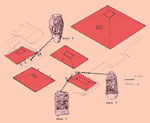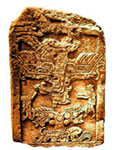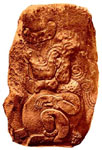|
MAJOR ARCHAEOLOGICAL SITES: PreClassic to PostClassic
IZAPA (circa 300 B.C.-A.D. 250)
 |
Izapa is located near the México-Guatemala border roughly 7 miles east of the town of Tapachula, Chiapas. The archaeological zone consists of eight principal mound groups. The largest pyramid is Mound 60 measuring approximately 335 feet square and towering to over 65 feet high. Most of the structures were erected of earth and rubble fill and faced with river cobbles. The entire matrix was then sealed with a clay surface that has since eroded away. Click on Image for more detail. |
 |
Monuments were found mainly within the confines of plazas arranged at the base of platforms and pyramids. Archaeologists located eighty-nine stelae of which thirty-eight had some portion of their surface carved. These were frequently paired with altars anticipating the stela-altar complexes that characterize Classic Maya sites for centuries afterward. Stela 1 depicts a water deity, or its impersonator, catching fish in a basket. The prognathous jaw and long lips are characteristic of Chaak, the rain god in Classic Maya art. Click on Image for more detail. |
 |
Stela 2 is thought to illustrate a scene from the Maya legend of the Popol Vuh origin story in which hero twins knock a giant macaw out of a fruit tree with a blow gun. The false god was later tricked into giving up his bejeweled eyes, beak, and teeth. Dismayed at his loss, the macaw god died. Click on Image for more detail. |
 |
According to the Popol Vuh, Zipacna was Seven Macaw’s son. When he killed four hundred relatives of the hero twins, they tricked the great crocodile into crawling beneath Mount Meauan where he was turned to stone. Click on Image for more detail. |
Previous Page | Sites Index | Next Page
Table of Contents
Return to top of page |


